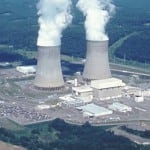The latest in a string of nuclear plants beset by technical troubles is PPL Corp.’s Susquehanna Nuclear Plant in northeastern Pennsylvania. The company said on Tuesday that a follow-up inspection of the Unit 1 main turbine at that two-reactor facility revealed “indications of cracks in blades” that are similar to damage discovered and repaired in 2011.
PPL said it plans to replace one row of blades in the Unit 1 turbine during the current refueling and maintenance outage and has decided as a precaution to shut down the Unit 2 reactor and inspect its main turbine after the Unit 1 outage is completed. The Unit 2 outage will be scheduled after Unit 1 resumes generating electricity.
The turbine blade replacement on the 1982-commissioned Unit 1 will have a minimal effect on the duration of the current outage, which began March 31 and is expected to continue into mid-May, PPL said. The financial impact to PPL Corp. from the additional turbine work at the Susquehanna plant, including energy sales margins and repair costs, is “not expected to be material,” it added.
"Inspecting the main turbine was one of the key planned tasks during the Unit 1 outage," Timothy Rausch, PPL Susquehanna senior vice president and chief nuclear officer said. "Well before the outage began, we planned and prepared for the possibility that the turbine inspection would result in a decision to replace blades."
During a Unit 2 refueling and generation uprate outage in April 2011, PPL found, in a planned inspection, cracks in “certain of its low pressure turbine blades,” the company says in recent documents. “Replacement of these blades was required, but was not anticipated as part of the original scope of this outage. The necessary replacement work extended the Unit 2 outage by six weeks.”
As a precaution, PPL Susquehanna also took Unit 1 out of service in mid-May 2011 to inspect its turbine blades. That inspection revealed cracks in blades similar to those found in Unit 2. The duration of the Unit 1 outage, in which turbine blades were replaced, was also about six weeks. According to the company, the after-tax earnings impact, including reduced energy-sales margins and repair expense for both units, was $63 million.
Diagnostic equipment installed on the turbines in 2011 has provided data about the possible causes of the problem, PPL said on Tuesday. As part of the ongoing Unit 1 outage and the upcoming Unit 2 outage, additional equipment will be installed that will, along with the analysis already conducted, be used to validate the suspected causes currently under engineering review.
Susquehanna is one of several plants that have recently shut down units to make repairs. Southern California Edison’s (SCE’s) beleaguered San Onofre Nuclear Generating Station has been shut down for most of this year—Unit 2 since being taken offline in January for maintenance, and Unit 3 since a leak was discovered in a steam generator tube on Jan. 31. Last month, the NRC ordered the plant to remain offline until the cause of the unusual wear was determined and corrected. The Los Angeles Times reported on Tuesday that SCE does not foresee the plant being closed for good. Senior Vice President Pete Dietrich told the newspaper that after "intensive study" of thermohydraulic conditions, eddy current testing and visual inspections using cameras inside the tubes, "we have made great progress in gaining an understanding of the situation."
Meanwhile, Progress Energy’s Crystal River Nuclear Plant in Florida has been shut down since the fall of 2009 and is expected to remain off-line until at least 2014 after the company discovered three instances of delamination, following tendon retensioning work. Progress has estimated that the bill for repairs and replacement power could top $2.5 billion. It is unclear who—the company or Florida customers—will cover those costs. Progress is expected to disclose an updated cost estimate for rebuilding the Crystal River facility. The company is also awaiting a decision from the insurer as to whether the claims will be paid or whether Progress will have to appeal to an arbitrator.
Sources: POWERnews, PPL Corp., Los Angeles Times








